Income Risk and the Decision on Onion Farming
Abstract
The onion cultivation often faced various risks caused by many factors, so farmers need to make the right decision to start onion cultivation by paying attention to these risks. Therefore, this research was conducted with the aim of 1) analyzing the income risk faced by farmers in developing onion farming, 2) knowing the factors that affect the farming risk, 3) knowing the factors that influence farmers' decisions in planting onion. The research was conducted in Purworejo Village for 4 months with 30 onion farmers as the sample. To analyze the income risk faced by farmers in developing onion farming, it was done by calculating the coefficient of variation (CV). Minimum income was calculated by the residual formula of the squared income function and to determine the factors that influence farming income and farmers' decisions in planting onion, multiple linear regression analysis was performed. The research showed that the risk of onion farming income was quite high, reached 79.72% and the factors that influence were land area, total production, selling price, and production costs. Meanwhile, the factors that influence the decision making of onion farmers were education, age, and farmer experience.
Downloads
References
Ghozali, M. R., & Wibowo, R. (2019). Analisis Risiko Produksi Usahatani Bawang Merah di Desa Petak Kecamatan Bagor Kabupaten Nganjuk. Jurnal Ekonomi Pertanian Dan Agribisnis, 3(2), 294–310. https://doi.org/10.21776/ub.jepa.2019.003.02.7
Harlan, J. (2018). Analisis Regresi Linear. In Journal of Chemical Information and Modeling (Vol. 53, Issue 9). https://doi.org/10.1017/CBO9781107415324.004
Kementerian Pertanian. (2016). Outlook Bawang Merah 2016. Pusat Data Dan Sistem Informasi Pertanian Kementerian Pertanian, 21. https://doi.org/1907-150
Kurnia Adhiwibowo dan Annisa Ramadhanty. (2019). Distribusi Perdagangan Komodits Bawang Merah Indonesia Tahun 2019. BPS-Statistics Indonesia.
Kurniati, D. (2014). Analisis Risiko Produksi Dan Faktor-Faktor Yang Mempengaruhinya Pada Usahatani Jagung (Zea mays L.) DI Kecamatan Mempawah Hulu Kabupaten Landak. Jurnal Social Economic of Agriculture, 1(3), 60–68. https://doi.org/10.26418/j.sea.v1i3.4366
Lawalata, M. (2017). Risiko Usahatani Bawang Merah di Kabupaten Bantul. Jurnal Agrica, 10(2), 56. https://doi.org/10.31289/agrica.v10i2.924
Mutisari, R. (Universitas B. (2019). Kata kunci : Risiko Produksi , Usahatani , Bawang Merah. Analisis Risiko Produksi Usahatani Bawang Merah Di Kota Batu, 3, 655–662.
Nduru, R. E., Situmorang, M., & Tarigan, G. (2014). Analisa Faktor-Faktor Yang Mempengaruhi Hasil Produksi Padi Di Deli Serdang. Saintia Matematika, 2(1), 71–83.
Pratiwi, L. F. L., & Hardyastuti, S. (2018). Analisis Faktor-Faktor Yang Mempengaruhi Pendapatan Usahatani Kentang Pada Lahan Marginal Di Kecamatan Kejajar Kabupaten Wonosobo. Berkala Ilmiah AGRIDEVINA, 7(1), 14–26. https://doi.org/10.33005/adv.v7i1.1127
Saptana, Daryanto, A., Daryanto, H. K., & Kuntjoro. (2010). Strategi manajemen resiko petani cabai merah pada sawah dataran rendah di Jawa Tengah. Jurnal Manajemen & Agribisnis.
Zuhriyah. (2012). Perilaku Petani Bawang Merah Dalam Mereduksi Risiko Sebagai Upaya Untuk Meningkatkan Produktivitas Usahatani (Studi Kasus di Kecamatan Batumarmar Kabupaten Pamekasan). Rekayasa, Volume 5,(Tri-Annual (April, August, and December)).













